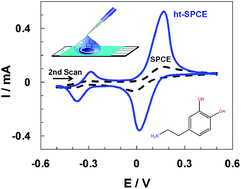Enhanced electrochemical sensing of polyphenols by an oxygen-mediated surface†
Abstract
We report a straightforward heat treatment in air of commercial screen-printed carbon electrodes (SPCE) at different temperatures and times (ht-SPCE) that produces considerable electrocatalytic effects. The active area and the presence of oxygen groups on the ht-SPCE surface increased upon thermal treatment, more than doubling and by 20%, respectively. The increase of oxygen-containing carbon surface groups results in strong interactions and substantial improvement in Faradaic currents, up to a 10 fold increase in the voltammetric response of relevant polyphenols (hydroquinone, catechol, pyrogallol and dopamine). Moreover, ht-SPCE displayed higher selectivity towards the oxidation of polyphenol mixtures than the untreated SPCE. Finally, good linear ranges were obtained by voltammetric determination of dopamine with detection and quantification limits 5 times lower than the values obtained for the untreated SPCE. The versatility of oxidation by air makes this activation procedure very attractive and easy to implement, which can be further used for numerous applications in the (bio)sensor field.


 Please wait while we load your content...
Please wait while we load your content...